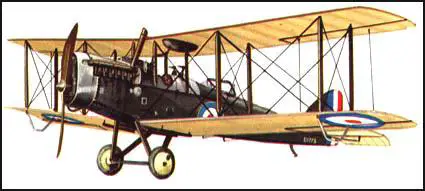Airco DH-4
Geoffrey de Havilland designed the Airco DH-4 in 1916 as a single-engined bomber and was so impressive in trials that it went into immediate production. The first of these aircraft were delivered to the Royal Flying Corps in March 1917. The pilot sat beneath the centre of the wing, with the gunner behind. The Airco DH-4 was easy to fly, could travel at over 100 mph and had a high ceiling of 23,500 feet (7,163 m) and was considered the best single-engineered bomber of the First World War.
German fighters were ineffective at these heights and so the Airco DH-4 did not need an escort on bombing missions. The DH-4 was also used for artillery spotting, photo-reconnaissance and coastal patrol work. The main problem with the Airco was caused by the fuel tank that was placed between the pilot and gunner. This made communication between the two men difficult. The position of the fuel tank meant that if hit by enemy fire, both men were in danger of being burnt to death. As a result the Airco DH-4 became known as the 'Flaming Coffin'. In 1918 the DH-4 was used for long-range bombing operations against Germany. A US-built version, the DH-4a, was also produced and over 1,880 of these were used on the Western Front.

Performance Data of the Airco DH4 | |
|---|---|
Type | two-seater bomber |
Engine | 250 hp Rolls Royce |
Wing Span | 42 ft 4 in (12.92 m) |
Length | 30 ft 8 in (9.35 m) |
Height | 11 ft (3.35 m) |
Maximum Speed | 143 mph (230 kph) |
Maximum Height | 23,500 ft (7,163 m) |
Endurance | 6 hours 45 minutes |
Armament | 2-4 machine-guns, 460 lb (208 kg) bomb load |
